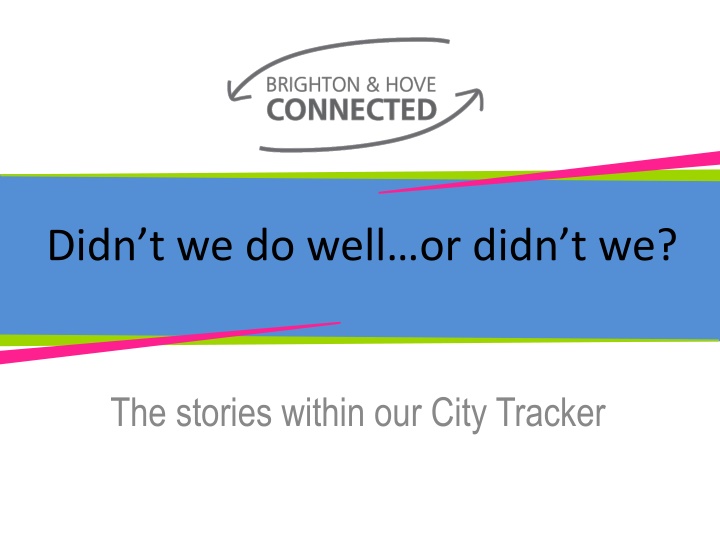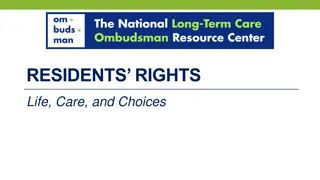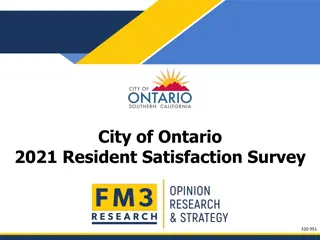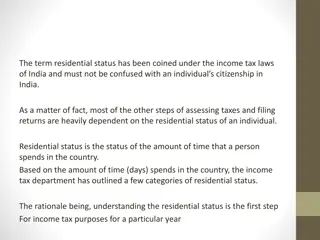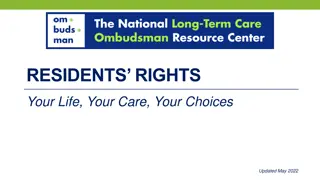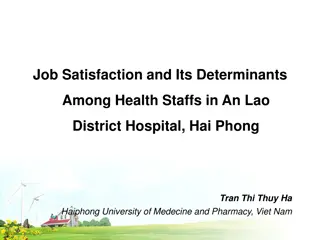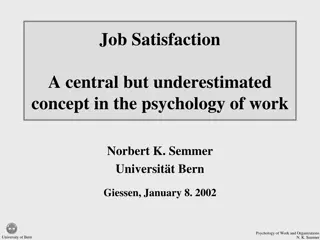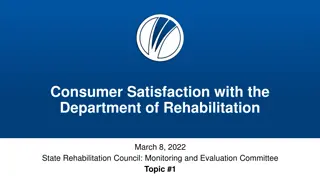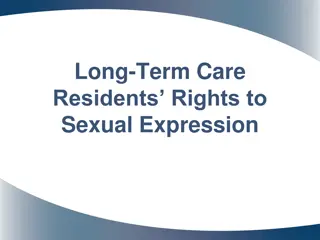City Tracker: Understanding Residents' Satisfaction in Brighton & Hove
The City Tracker report delves into the demographic composition and satisfaction levels of residents in Brighton & Hove. It highlights the increasing diversity and aging population of the city, alongside residents' contentment with living in the area. Despite uncertainties surrounding Brexit, the majority express satisfaction with both the local area and Brighton & Hove as a place to live, reflecting a positive sentiment towards the city's environment.
Download Presentation

Please find below an Image/Link to download the presentation.
The content on the website is provided AS IS for your information and personal use only. It may not be sold, licensed, or shared on other websites without obtaining consent from the author.If you encounter any issues during the download, it is possible that the publisher has removed the file from their server.
You are allowed to download the files provided on this website for personal or commercial use, subject to the condition that they are used lawfully. All files are the property of their respective owners.
The content on the website is provided AS IS for your information and personal use only. It may not be sold, licensed, or shared on other websites without obtaining consent from the author.
E N D
Presentation Transcript
Didnt we do wellor didnt we? The stories within our City Tracker
Understanding Our Residents We are a young, increasingly diverse city but we are changing We are ageing as people are living longer The proportion of older people in the City is growing We are living more years in poor health We are projected to grow as a city and reach 314,000 by 2030 However, the implications of Brexit on our population size and structure are still unknown
Respondent profile Demographic Sample Profile (unweighted) Weighted Profile Gender Male Female 18-34 35-54 55+ White British Other White Black & Minority Ethnic (BME) Disability/Health problem BN1 BN2 BN3 BN41 42% 58% 18% 54% 29% 85% 8% 7% 50% 50% 38% 36% 26% 83% 9% 8% Age Ethnicity Health Postcode sector 16% 35% 32% 28% 6% 16% 33% 31% 29% 7%
Headline Findings People are generally satisfied with living in the city 2017 City Tracker % 2016 City Tracker % Difference National comparison + 1% Satisfaction with local area as a place to live 90 89 81 - Satisfaction with B & H as a place to live 87 87 None
Satisfaction with Brighton & Hove as a place to live Overall, 87% of Brighton & Hove residents are satisfied with the city as a place to live Very Dissatisfied Fairly satisfied Fairly dissatisfied Very satisfied Neither 4% 5% 38% 49% Fewer than one in ten (7%) are dissatisfied 3% More residents are very satisfied in 2017 than was the case last year, or in 2015 Q1a Overall, how satisfied are you with Brighton & Hove as a place to live? Base: All including don t knows (1002) 5
Satisfaction with local area as a place to live Nine in ten Brighton & Hove residents (90%) are satisfied with their local area as a place to live Very Dissatisfied Fairly satisfied Fairly dissatisfied Very satisfied Neither Residents are more likely to be very satisfied than was the case one year ago, when 47% gave this rating for their local areas 4%4% 35% 55% 2% Q1b Overall, how satisfied are you with your local area as a place to live (by this I mean the area within a 15-20 minute walk from your home)? Base: All including don t knows (1002) 6
However Satisfaction* varies across postcodes and demographic groups within the city 57% 51% BN1 BN3 43% 34% BN2 BN41 (* % of residents reporting to be very satisfied with their local area as a place to live)
Dissatisfaction varies by demographic group Looked at 31 groups across the following demographics: Gender Age Health disability Tenure Carers Sexuality BME Connection to the arm forces Location / postal area
Understanding our residents The type of resident most likely to respond negatively; Has a health problem or disability that affected their activity a lot Rents their home from a social landlord Has caring responsibilities Is aged 25 to 34 and Lives in BN41 or BN2
Understanding our residents They type of resident least likely to responded negatively; Is buying their home on a mortgage Lives in BN1 Is aged 35 to 44 or 55 to 64 and Has no health problem or disability that affected their activity.
However, strength of feeling within these groups also varies Overall, how satisfied or dissatisfied are you with your local area as a place to live? While, numbers within the BN41 postcode who are very or fairly satisfied are comparatively low, the number reporting that they were actually dissatisfied was 0. Postcode District BN41 1 / BN41 2 BN1 BN2 BN3 Total Very or fairly satisfied Neither satisfied nor dissatisfied Fairly or very dissatisfied 319 252 273 60 904 96.4% 81.0% 94.1% 84.5% 90.1% 4 20 3 11 38 1.2% 6.4% 1.0% 15.5% 3.8% 7 38 14 0 59 2.1% 12.2% 4.8% 0.0% 5.9% 1 1 0 0 2 Don t know .3% .3% 0.0% 0.0% .2% Total 331 311 290 71 1003 100.0% 100.0% 100.0% 100.0% 100.0%
Whats great about Brighton and Hove? Residents were asked what they think is great about Brighton & Hove in 2017 What s great about Brighton and Hove in 2017? Things to do/arts & culture/vibrant (n=357) 36% Diverse/cosmop/liberal/voted remain (n=197) 20% Seafront/living by sea (n=175) 17% Friendly/tolerant/peope/inclusive (n=172) 17% Good place to live/atmosphere (n=146) 15% Parks/downs/green spaces (n=84) 8% The most popular answer was arts and culture Good for children/family/young people (n=37) 4% Public transport (n=21) 2% Safe (n=15) 1% Shopping (n=13) 1% Weather (n=13) 1% Football (n=12) 1% New cycle scheme (n=11) 1% Other (n=41) 4% Don't know (n=75) 7% None (n=84) 8% Source: Brighton & Hove City Tracker, 2017 Base: All respondents who answered the question (n=1,002)
However uptake of the cultural offer shows significant differences between demographic groups If you are a council tenant, have a health problem or disability that affects your activity a lot, live in BN41 (Portslade) and or are aged 75 or older you are significantly more likely not to have attendant a cultural event in the last year. Percentage of residents who have not attended a cultural event in the last year Not attended a creative, artistic, theatrical or musical event Live in social housing 67% Own home either out right or on a mortgage 30% Live in BN41 (Portslade) 61% BN1 (central Brighton) 30% Aged 75 or older 56% Aged 35 to 64 29% However, if you have a mortgage, live in BN1 (central Brighton) and or are aged 45 to 55 you are significantly less likely not to have a attended a cultural event in the last year. Not visited a museum or gallery in the last year Live in social housing 75% Own home either out right or on a mortgage 37% Live in BN41 (Portslade) 60% BN1 (central Brighton) 34% Aged 75 or older 64% Aged 35 to 64 36%
The JAMs (Just About Managing) Percentage of residents who strongly or tend to disagree that they will have enough money after housing cost to meet basic living costs (food, water and heating). * Home - Rent from Housing Association / Trust (n=47) 43% 42% * Health/disability affecting activity a lot (n=89) 38% 38% 37% * Home - Rent from private landlord (n=188) 32% 31% 30% * Carer - Yes (n=134) * Aged 25-34 (n=301) 28% 26% 25% H'hold with at least one child under 18 (n=307) Residents who rent, are aged 18 to 34, have a health problem or disability that affects their activity a lot, are BME, and or a carer are all significantly more likely to think that they will not have enough money for food, water and heating. Older residents and residents who own their home (outright or on a mortgage) are significantly less likely to think they will not have enough money. 23% 22% Female (n=499) 21% 21% 21% 19% 19% 19% 19% 19% 19% 19% 18% 18% 17% 16% Heterosexual / straight (n=859) BN3 (n=290) BN1 (n=331) LGB (n=79) White UK / British (n=832) Aged 35-44 (n=107) Connection to Forces - Yes (n=85) 13% 12% 11% Aged 65-74 (n=93) * Aged 75+ (n=76) 9% 9%
Economic Strategy Background evidence gathering identified that despite the strong labour market, there are concentrations of severe relative multiple deprivation in Brighton. A small number of the city s localities are classified as being in the 10% most deprived areas in England. There are five localities that are in the 2% most deprived areas in the country with most being found in East Brighton.
What would you like Brighton and Hove to be like in 2030? Base: All respondents who answered the question (n=1,002)
Lenses on the Tracker Economic Social Democratic
Economic What are the implications in terms of economic inclusivity?
Social What are the implications for social cohesion/ division?
Democratic What is the role of city leadership in bringing all this together?
Workshops To Discuss: What are the implications in terms of economic inclusivity? What are the implications for social cohesion/division? What is the role of city leadership in bringing all this together?
